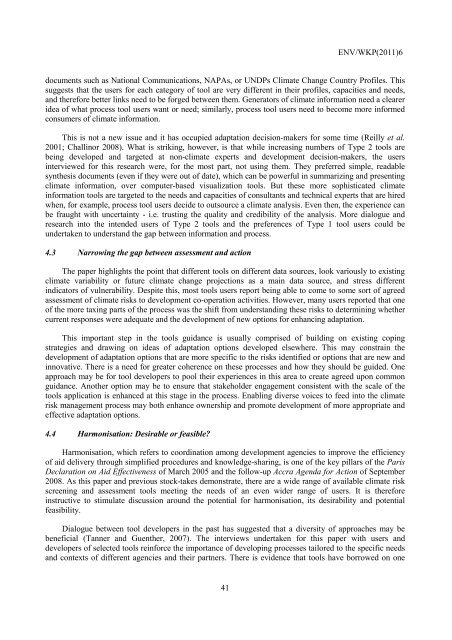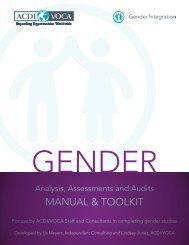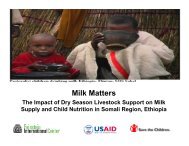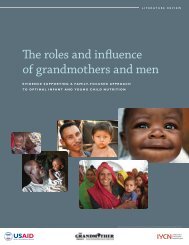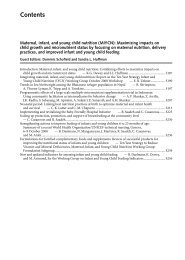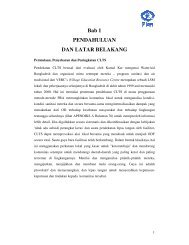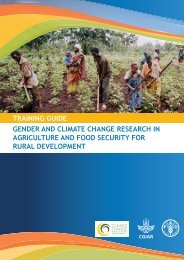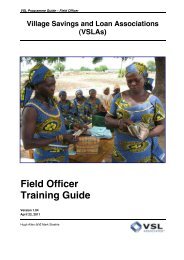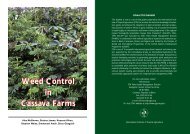Harmonising Climate Risk Management - International Institute for ...
Harmonising Climate Risk Management - International Institute for ...
Harmonising Climate Risk Management - International Institute for ...
- No tags were found...
You also want an ePaper? Increase the reach of your titles
YUMPU automatically turns print PDFs into web optimized ePapers that Google loves.
ENV/WKP(2011)6documents such as National Communications, NAPAs, or UNDPs <strong>Climate</strong> Change Country Profiles. Thissuggests that the users <strong>for</strong> each category of tool are very different in their profiles, capacities and needs,and there<strong>for</strong>e better links need to be <strong>for</strong>ged between them. Generators of climate in<strong>for</strong>mation need a cleareridea of what process tool users want or need; similarly, process tool users need to become more in<strong>for</strong>medconsumers of climate in<strong>for</strong>mation.This is not a new issue and it has occupied adaptation decision-makers <strong>for</strong> some time (Reilly et al.2001; Challinor 2008). What is striking, however, is that while increasing numbers of Type 2 tools arebeing developed and targeted at non-climate experts and development decision-makers, the usersinterviewed <strong>for</strong> this research were, <strong>for</strong> the most part, not using them. They preferred simple, readablesynthesis documents (even if they were out of date), which can be powerful in summarizing and presentingclimate in<strong>for</strong>mation, over computer-based visualization tools. But these more sophisticated climatein<strong>for</strong>mation tools are targeted to the needs and capacities of consultants and technical experts that are hiredwhen, <strong>for</strong> example, process tool users decide to outsource a climate analysis. Even then, the experience canbe fraught with uncertainty - i.e. trusting the quality and credibility of the analysis. More dialogue andresearch into the intended users of Type 2 tools and the preferences of Type 1 tool users could beundertaken to understand the gap between in<strong>for</strong>mation and process.4.3 Narrowing the gap between assessment and actionThe paper highlights the point that different tools on different data sources, look variously to existingclimate variability or future climate change projections as a main data source, and stress differentindicators of vulnerability. Despite this, most tools users report being able to come to some sort of agreedassessment of climate risks to development co-operation activities. However, many users reported that oneof the more taxing parts of the process was the shift from understanding these risks to determining whethercurrent responses were adequate and the development of new options <strong>for</strong> enhancing adaptation.This important step in the tools guidance is usually comprised of building on existing copingstrategies and drawing on ideas of adaptation options developed elsewhere. This may constrain thedevelopment of adaptation options that are more specific to the risks identified or options that are new andinnovative. There is a need <strong>for</strong> greater coherence on these processes and how they should be guided. Oneapproach may be <strong>for</strong> tool developers to pool their experiences in this area to create agreed upon commonguidance. Another option may be to ensure that stakeholder engagement consistent with the scale of thetools application is enhanced at this stage in the process. Enabling diverse voices to feed into the climaterisk management process may both enhance ownership and promote development of more appropriate andeffective adaptation options.4.4 Harmonisation: Desirable or feasible?Harmonisation, which refers to coordination among development agencies to improve the efficiencyof aid delivery through simplified procedures and knowledge-sharing, is one of the key pillars of the ParisDeclaration on Aid Effectiveness of March 2005 and the follow-up Accra Agenda <strong>for</strong> Action of September2008. As this paper and previous stock-takes demonstrate, there are a wide range of available climate riskscreening and assessment tools meeting the needs of an even wider range of users. It is there<strong>for</strong>einstructive to stimulate discussion around the potential <strong>for</strong> harmonisation, its desirability and potentialfeasibility.Dialogue between tool developers in the past has suggested that a diversity of approaches may bebeneficial (Tanner and Guenther, 2007). The interviews undertaken <strong>for</strong> this paper with users anddevelopers of selected tools rein<strong>for</strong>ce the importance of developing processes tailored to the specific needsand contexts of different agencies and their partners. There is evidence that tools have borrowed on one41


